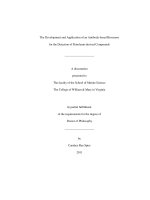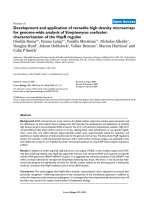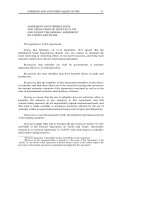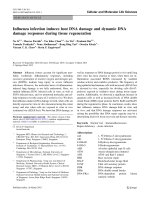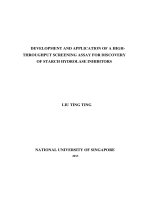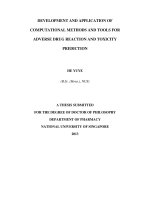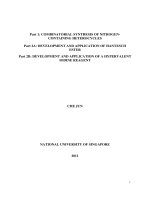Development and application of solvent minimized extraction technologies
Bạn đang xem bản rút gọn của tài liệu. Xem và tải ngay bản đầy đủ của tài liệu tại đây (845.42 KB, 213 trang )
DEVELOPMENT AND APPLICATION OF
SOLVENT-MINIMIZED EXTRACTION TECHNOLOGIES
GUO LIANG
NATIONAL UNIVERSITY OF SINGAPORE
2012
DEVELOPMENT AND APPLICATION OF
SOLVENT-MINIMIZED EXTRACTION TECHNOLOGIES
GUO LIANG
(M.Sc., TSINGHUA UNIVERSITY)
A THESIS SUBMITTED
FOR THE DEGREE OF DOCTOR OF PHILOSOPHY
DEPARTMENT OF CHEMISTRY
NATIONAL UNIVERSITY OF SINGAPORE
2012
Thesis Declaration
The work in this thesis is the original work of GUO LIANG, performed independently
under the supervision of Professor Lee Hian Kee, (in the laboratory of Microscale
Analytical Chemistry), Department of Chemistry, National University of Singapore,
between Jan 2006 and Dec 2009.
The content of the thesis has been partly published in:
(1) L. Guo, H.K. Lee, Electro membrane extraction followed by low-density solvent
based
ultrasound-assisted
derivatization
for
emulsification
determining
microextraction
chlorophenols
and
combined
analysis
by
with
gas
chromatography–mass spectrometry, Journal of Chromatography A, 1243 (2012) 14.
(2) L. Guo, H.K. Lee, One step solvent bar microextraction and derivatization
followed by gas chromatography–mass spectrometry for the determination of
pharmaceutically
active
compounds
in
drain
water
samples,
Journal
of
Chromatography A, 1235 (2012) 26.
(3) L. Guo, H.K. Lee, Low-density solvent based ultrasound-assisted emulsification
microextraction
and
on-column
derivatization
combined
with
gas
chromatography–mass spectrometry for the determination of carbamate pesticides in
environmental water samples, Journal of Chromatography A, 1235 (2012) 1.
i
(4) L. Guo, H.K. Lee, Development of multiwalled carbon nanotubes based
micro-solid-phase extraction for the determination of trace levels of sixteen polycyclic
aromatic hydrocarbons in environmental water samples, Journal of Chromatography
A, 1218 (2011) 9321.
(5) L. Guo, H.K. Lee, Low-density solvent-based solvent demulsification dispersive
liquid-liquid microextraction for the fast determination of trace levels of sixteen
priority polycyclic aromatic hydrocarbons in environmental water samples, Journal of
Chromatography A, 1218(2011), 5040.
(6) L. Guo, H.K. Lee, Ionic liquid based three-phase liquid-liquid-liquid solvent bar
microextraction for the determination of phenols in seawater samples, Journal of
Chromatography A, 1218 (2011) 4299.
Name
Signature
Date
ii
Acknowledgements
First of all, I would like to express my sincere gratitude to my supervisor, Professor
Lee Hian Kee, for his invaluable suggestions, guidance, moral support and
encouragement throughout the whole work.
I appreciated the financial assistance provided by the National University of
Singapore during my Ph.D. candidature.
I am grateful to the my colleagues, Dr Chanbasha Bashaeer, Dr Zhang Jie, Dr Wu
Jinming, Ms. Tan Yen Ling, Dr Xu Li, Mr Hii Toh Ming, Mr Nyi Nyi Naing, Mr Lim
Tze Han, Ms Zhang Hong, Mr Seyed Mohammad Majedi, Ms Maryam Lashgari, and
Mr Tang Sheng who gave me their help in many ways. Appreciation is also address to
my friends for their enthusiastic help.
I would like to express my special thanks to Ms Frances Lim and Dr. Liu Qiping for
their technical assistance during my work. Appreciation is also addressed to many
other laboratory officers in the Department of Chemistry, and the staff in the General
Office of the Department for their help and assistance.
Finally, I am greatly indebted to my parents, sister, and wife for their endless love,
concern, support and encouragement all these years.
iii
Table of Contents
Thesis Declaration .....................................................................................................
i
Acknowledgements.................................................................................................... iii
Table of Contents....................................................................................................... iv
Summary .................................................................................................................... xiii
List of Tables ............................................................................................................. xvi
List of Figures ............................................................................................................xvii
List of Abbreviations ................................................................................................. xx
Chapter 1 Introduction ...............................................................................................
1.1
Sample preparation .......................................................................................
1
1
1.1.1
Preamble.................................................................................................
1
1.1.2
Sample preparation techniques ..............................................................
2
Sorptive based microextraction techniques ..................................................
4
1.2
1.2.1
Solid-phase microextraction ..................................................................
4
1.2.2
Stir bar sorptive extraction.....................................................................
7
1.2.3
Micro solid-phase extraction..................................................................
8
Solvent based microextraction techniques ....................................................
9
1.3
1.3.1
Single drop microextraction...................................................................
9
1.3.2
Hollow fiber protected liquid-phase microextraction ............................ 16
1.3.3
Solvent bar microextraction ................................................................... 20
iv
1.3.4
Solidified floating organic drop microextraction................................... 21
1.3.5
Dispersive liquid-liquid microextraction ............................................... 22
1.3.6
Electro membrane extraction ................................................................. 25
1.4
Objectives of this work.................................................................................. 26
Chapter 2 One Step Solvent Bar Microextraction and Derivatization Followed by
Gas Chromatography–Mass Spectrometry for the Determination of Pharmaceutically
Active Compounds in Drain Water Samples ............................................................. 30
2.1
Introduction .................................................................................................. 30
2.2
Experimental................................................................................................. 33
2.2.1
Chemicals and materials ........................................................................ 33
2.2.2
Apparatus and instrumentation .............................................................. 34
2.2.3
GC–MS analysis .................................................................................... 35
2.2.4
Sample preparation ................................................................................ 35
2.2.5
SBME with derivatization...................................................................... 36
2.2.6
Conventional HF-LPME with derivatization......................................... 37
2.2.7
SPME with derivatization ...................................................................... 38
2.3
Results and discussion................................................................................... 38
2.3.1
Principle of SBME ................................................................................. 38
2.3.2
Comparative studies............................................................................... 39
2.3.3
Derivatization......................................................................................... 41
2.3.3.1
Derivatization regent............................................................... 41
2.3.3.2
Volume ratio of derivatization regent ..................................... 42
v
2.3.3.3
2.3.4
Derivatization time and temperature....................................... 43
Optimization........................................................................................... 43
2.3.4.1
The type of organic solvent..................................................... 43
2.3.4.2
The pH of sample solution...................................................... 44
2.3.4.3
The effect of extraction temperature....................................... 45
2.3.4.4
Extraction time profiles........................................................... 46
2.3.4.5
Effect of ionic strength............................................................ 47
2.3.4.6
Agitation speed ....................................................................... 49
2.3.5
Method validation .................................................................................. 50
2.3.6
Genuine water sample analysis .............................................................. 51
2.4
Conclusion..................................................................................................... 53
Chapter 3
Ionic Liquid Based Three-Phase Liquid-Liquid-Liquid Solvent Bar
Microextraction for the determination of Phenols in Seawater Samples................... 55
3.1
Introduction .................................................................................................. 55
3.2
Experimental................................................................................................. 57
3.2.1
Chemicals and materials ........................................................................ 57
3.2.2
Apparatus and instrumentation .............................................................. 58
3.2.3
Sample preparation ................................................................................ 59
3.2.4
IL-LLL-SBME ....................................................................................... 60
3.2.5
Conventional LLL-SBME (non-IL-LLL-SBME).................................. 60
3.2.6
Ionic liquid supported HF-LLLME (IL-LLL-LLLME)......................... 60
3.3
Results and discussion................................................................................... 61
vi
3.3.1
Basic principle of IL-LLL-SBME.......................................................... 61
3.3.2
Enrichment factor................................................................................... 61
3.3.3
Comparative studies............................................................................... 63
3.3.4
Optimization........................................................................................... 64
3.3.4.1
The selection of ionic liquid ................................................... 64
3.3.4.2
Composition of donor phase and acceptor phase.................... 65
3.3.4.3
The effect of extraction temperature....................................... 67
3.3.4.4
Extraction time profiles........................................................... 68
3.3.4.5
Effect of ionic strength............................................................ 68
3.3.4.6
Agitation speed ....................................................................... 70
3.3.5
Method validation .................................................................................. 71
3.3.6
Genuine water sample analysis .............................................................. 72
3.4
Conclusion..................................................................................................... 73
Chapter 4
Low-density Solvent Based Ultrasound-assisted Emulsification
Microextraction
and
On-column
Derivatization
Combined
with
Gas
Chromatography–Mass Spectrometry for the Determination of Carbamate Pesticides
in Environmental Water Samples .............................................................................. 75
4.1
Introduction .................................................................................................. 75
4.2
Experimental................................................................................................. 78
4.2.1
Chemicals and materials ........................................................................ 78
4.2.2
GC–MS analysis .................................................................................... 79
4.2.3
Sample preparation ................................................................................ 81
vii
4.2.4
LDS-USAEME with on-column derivatization..................................... 81
4.2.5
Conventional USAEME......................................................................... 81
4.2.6
LDS-DLLME ......................................................................................... 82
4.3
Results and discussion................................................................................... 82
4.3.1
Comparative studies............................................................................... 82
4.3.2
Derivatization......................................................................................... 83
4.3.3
Optimization........................................................................................... 85
4.3.3.1
Extraction solvent ................................................................... 85
4.3.3.2
Volume of the extraction solvent............................................ 86
4.3.3.3
Extraction temperature............................................................ 87
4.3.3.4
Extraction time profiles........................................................... 88
4.3.3.5
Effect of ionic strength............................................................ 89
4.3.3.6
Time and speed of centrifugation ........................................... 90
4.3.4
Method validation .................................................................................. 91
4.3.5
Genuine water sample analysis .............................................................. 91
4.4
Conclusion..................................................................................................... 93
Chapter 5 Electro Membrane Extraction Followed by Low-Density Solvent Based
Ultrasound-Assisted Emulsification Microextraction Combined with Derivatization
for Determining Chlorophenols and Analysis by Gas Chromatography–Mass
Spectrometry .............................................................................................................. 94
5.1
Introduction .................................................................................................. 94
5.2
Experimental................................................................................................. 96
viii
5.2.1
Chemicals and materials ........................................................................ 96
5.2.2
GC–MS analysis .................................................................................... 98
5.2.3
Sample preparation ................................................................................ 98
5.2.4
EME-LDS-USAEME............................................................................. 98
5.3
Results and discussion................................................................................... 100
5.3.1
Derivatization......................................................................................... 100
5.3.2
Optimization........................................................................................... 101
5.3.2.1
The type of organic solvent for SLM.................................... 101
5.3.2.2
Voltage of EME .................................................................... 103
5.3.2.3
EME duration........................................................................ 105
5.3.2.4
Effect of pH of donor and acceptor solution......................... 106
5.3.2.5
Effect of agitation speed ....................................................... 108
5.3.2.6
Effect of ionic strength.......................................................... 109
5.3.2.7
Extraction solvent and its volume of LDS-USAEME .......... 109
5.3.2.8
Ultrasonication time and temperature................................... 111
5.3.2.9
Speed and time of centrifugation .......................................... 112
5.3.3
Method validation .................................................................................. 112
5.3.4
Genuine water sample analysis .............................................................. 113
5.4
Conclusion..................................................................................................... 114
ix
Chapter 6
Low-Density Solvent-Based Solvent Demulsification Dispersive
Liquid-liquid Microextraction for the Fast Determination of Trace Levels of Sixteen
Priority Polycyclic Aromatic Hydrocarbons in Environmental Water Samples ....... 117
6.1
Introduction ................................................................................................ 117
6.2
Experimental................................................................................................. 119
6.2.1
Chemicals and materials ........................................................................ 119
6.2.2
GC–MS analysis .................................................................................... 119
6.2.3
Sample preparation ................................................................................ 120
6.2.4
LDS-SD-DLLME................................................................................... 120
6.3
Results and discussion................................................................................... 122
6.3.1
6.3.2
Comparative studies............................................................................... 122
6.3.1.1
Conventional DLLME.......................................................... 122
6.3.1.2
LDS-DLLME ....................................................................... 122
6.3.1.3
USAEME.............................................................................. 123
Optimization........................................................................................... 124
6.3.2.1
The selection of extraction solvent ....................................... 124
6.3.2.2
The volume of the extraction solvent.................................... 125
6.3.2.3
Selection of dispersive solvent and demulsification solvent 126
6.3.2.4
Volume of the dispersive solvent and the demulsification
solvent .................................................................................................... 127
6.3.2.5
6.3.3
Extraction time profiles......................................................... 128
Method validation .................................................................................. 130
x
6.3.4
6.4
Genuine water sample analysis .............................................................. 131
Conclusion..................................................................................................... 133
Chapter
7
Development
of
Multiwalled
Carbon
Nanotubes
Based
Micro-Solid-Phase Extraction for the Determination of Trace Levels of Sixteen
Polycyclic Aromatic Hydrocarbons in Environmental Water Samples..................... 134
7.1
Introduction .................................................................................................. 134
7.2
Experimental................................................................................................. 136
7.2.1
Chemicals and materials ........................................................................ 136
7.2.2
GC–MS analysis .................................................................................... 137
7.2.3
Sample preparation ................................................................................ 138
7.2.4
µ-SPE ..................................................................................................... 138
7.2.5
SPE......................................................................................................... 139
7.2.6
DI-SPME and HS-SPME ....................................................................... 139
7.2.7
SBME..................................................................................................... 140
7.3
Results and discussion................................................................................... 141
7.3.1
Sorbent selection .................................................................................... 141
7.3.2
Optimization........................................................................................... 142
7.3.2.1
Amount of sorbent material .................................................. 142
7.3.2.2
Extraction time profiles......................................................... 143
7.3.2.3
Effect of extraction temperature ........................................... 144
7.3.2.4
Agitation speed ..................................................................... 146
7.3.2.5
Desorption solvent and desorption time ............................... 146
xi
7.3.2.6
Effect of organic modifier..................................................... 148
7.3.2.7
Effect of ionic strength.......................................................... 149
7.3.3
Method validation .................................................................................. 150
7.3.4
Comparative studies............................................................................... 152
7.3.5
Genuine water sample analysis .............................................................. 155
7.4
Conclusion..................................................................................................... 157
Chapter 8 Conclusion................................................................................................. 158
References .................................................................................................163
List of Publications....................................................................................187
xii
Summary
Sample preparation is a key role in modern analytical method, especially in dealing
with complex sample matrices, which isolating the target analytes from sample
matrices and rendering them suitable for the analytical steps. Among the recently
developed
sample
preparation
methods,
solvent-miniaturized
and
environmental-friendly microextraction methodologies have attracted the most
attention in recent years. This thesis described the development of several novel
microextraction techniques and their applicability in environmental sample analysis.
Firstly, solvent bar microextraction (SBME) was coupled with simultaneous
derivatization to determine pharmaceutically active compounds (PhACs) in
environmental water samples. The derivatization reagent was added in the extraction
solvent (solvent bar), so that the analytes could be extracted from the aqueous sample
and simultaneously derivatized in the solvent bar. After extraction, the derivatized
analytes in the extract could be directly analyzed by gas chromatography-mass
spectrometry (GC–MS). The results showed that this method could be a fast and
efficient alternative to traditional method, in which the extraction and derivatization
were two separated steps. In ionic liquid supported three-phase liquid-liquid-liquid
solvent
bar
microextraction
(IL-LLL-SBME),
an
ionic
liquid,
1-butyl-3-methylimidazolium hexafluorophosphate ([BMIM][PF6]), was developed as
the intermediary solvent for LLL-SBME instead of the conventional used organic
xiii
solvents. The analytes were extracted from sample solution into the ionic liquid phase
impregnated in the pores of the hollow fiber and finally, back-extracted into acceptor
solution in the lumen of the hollow fiber. Since an ionic liquid was used, this method
was totally organic solvent free and environmentally friendly.
Secondly, several low-density solvent based dispersive liquid-liquid microextraction
(DLLME)
techniques
were
developed.
In
low-density
solvent
based
ultrasound-assisted emulsification microextraction (LDS-USAEME), the emulsion
was formed with the assistance of ultrasounication; avoid the use of dispersive solvent,
greatly reducing the amount of organic solvent in the procedure. Combined with
on-column derivatization, this approach provided a simple and efficient method for
determining carbamate pesticides in aqueous samples with the limits of detection
(LODs) as low as 0.01 µg/L.
Furthermore, a highly efficient two-step method, electro membrane extraction (EME)
coupled to LDS-USAEME, was developed. In EME, the analytes were extracted from
the sample solution into the acceptor solution under electrical potential, which was
then employed as the sample solution for the USAEME, in which the analytes was
further extracted into the extraction solvent. Due to the protection afforded by the
membrane in EME, the method could be directly used for complex matrices,
overcoming the limitation of conventional USAEME. With the combined two-step
procedure, high enrichment factors (up to 2198) could be achieved for chlorophenols.
xiv
In low-density solvent-based solvent demulsification DLLME, after extraction,
instead of break up the emulsion by centrifugation, a demulsification solvent was
injected into the aqueous solution to break up the emulsion, which separated into two
layers. The procedure was convenient and has the potential to be applied in field since
no power-based centrifugation was required.
In these three low-density-solvent-based DLLME methods, a flexible and disposable
polyethylene pipette was used as extraction device in the procedure, which permitted
a solvent with a density lighter than water to be used as extraction solvent, broadening
the range of organic solvents for DLLME, and also provided the convenient collection
of upper layer of extraction solvent.
Lastly, micro-solid-phase extraction (µ-SPE) was developed for the determination of
trace level of 16 polycyclic aromatic hydrocarbons in river water samples.
Multiwalled carbon nanotubes was employed as µ-SPE sorbent. The large surface
area afforded by the MWCNTs and their π-π electrostatic interactions with the
aromatic rings of the analytes facilitated strong adsorption between the two species.
After extraction, analyte desorption was carried out with a suitable organic solvent
under ultrasonication. Due to the protection provided by the porous polypropylene
membrane in µ-SPE, no additional cleanup step was required. The results showed that
the method could provide high extraction efficiency for the analysis of PAHs.
xv
List of Tables
Table 2-1 Chemical structures of PhACs considered in this study
Table 2-2 Linear range, LOD, LOQ, and precision of SBME with derivatization of
PhACs
Table 2-3 Summary of results from analysis of PhACs in genuine drain water samples
and spiked genuine drain water samples by SBME with derivatization
Table 3-1 Physical properties of target phenols
Table 3-2 Linear range, LOD, enrichment factors, relative recoveries, and precision of
phenols of IL-LLL-SBME
Table 3-3 Summary of results of analysis of phenols in spiked genuine seawater
samples by IL-LLL-SBME
Table 4-1 Chemical structures of carbamate pesticides considered in this work
Table 4-2 Linear range, LOD, LOQ, recovery, and precision of LDS-USAEME with
on-column derivatization and GC–MS analysis of carbamate pesticides
Table 4-3 Summary of results of LDS-USAEME combined with on-column
derivatizatin and GC–MS analysis of carbamate pesticides in spiked genuine river
water sample
Table 5-1 Physical properties of target chlorophenols
Table 5-2 Linear range, LOD, LOQ, enrichment factor, and precision of
EME-LDS-USAEME of chlorophenols
Table 5-3 Summary of results from analysis of chlorophenols in spiked genuine
drainwater samples by EME-LDS-USAEME
Table 6-1 Linear range, LOD, LOQ, recovery, and precision of PAHs of
LDS-SD-DLLME method
Table 6-2 PAHs in genuine rainwater samples determined by LDS-SD-DLLME
Table 7-1 Linear range, LOD, LOQ, recovery, and precision of PAHs of µ-SPE and
GC–MS
Table 7-2 PAHs in genuine river water samples determined by µ-SPE and GC-MS
xvi
List of Figures
Figure 2-1 Comparison of SPME, SBME, and HF-LPME.
Figure 2-2 Effect of organic solvent:MTBSTFA ratios on extraction.
Figure 2-3 Effect of the type of organic solvent on extraction.
Figure 2-4 Effect of sample pH on extaction.
Figure 2-5 Effect of temperature on extraction.
Figure 2-6 Extraction time profiles.
Figure 2-7 Effect of ionic strength on the extraction.
Figure 2-8 Effect of agitation speed on extraction.
Figure 2-9 Chromatogram of extractant of a spiked wastewater sample under the most
favorable extraction conditions, as given in the text. (1) Ibuprofen, (2) alprenolol, (3)
naproxen, (4) propranolol, (5) ketoprofen, (6) diclofenac.
Figure 3-1 Comparison of phenol peak areas in Non-IL-LLL-SBME, IL-LLL-SBME,
and IL-HF-LLLME.
Figure 3-2 Comparison of use of different ionic liquids for IL-LLL-SMBE.
Figure 3-3 Effect of acceptor solution pH on extraction efficiency.
Figure 3-4 Effect of extraction temperature on extraction efficiency.
Figure 3-5 Extraction time profile of IL-LLL-SBME.
Figure 3-6 Effect of ionic strength on extraction efficiency.
Figure 3-7 Effect of agitation speed
Figure 3-8 Chromatogram of spiked genuine seawater sample under the most
favorable extraction conditions.
(1) 4-chlorophenol, (2) 2-nitrophenol, (3)
2,3-dichlorophenol, (4) 2,4-dichlorophenol, (5) 2,4,6-trichlorophenol, (6)
pentachlorophenol.
Figure 4-1 Mass spectra of carbamate pesticide derivatives.
Figure 4-2 Comparison of LDS-DLLME, USAEME, and LDS-USAEME.
xvii
Figure 4-3 Effect of derivatization reagent volume on extraction.
Figure 4-4 Effect of type of extraction solvent on extraction.
Figure 4-5 Effect of extraction solvent volume on extraction.
Figure 4-6 Effect of temperature on extraction.
Figure 4-7 Extraction time profiles.
Figure 4-8 Chromatogram of spiked river water sample extracted by LDS-USAEME
under the most favorable conditions as described in the text. (1) Promecarb, (2)
Carbofuran, (3) Propham, (4) Carbaryl, (5) Methiocarb, (6) Chlorpropham.
Figure 5-1. Schematic of EME-LDS-USAEME: (a) EME (first step) and (b)
LDS-USAEME (second step). For clarity, the schematic is not to scale. In (b), (A)
aqueous sample solution, (B) emulsification, (C) emulsion is broken, (D) collection of
the organic extract.
Figure 5-2 Effect of extract:MTBSTFA ratios on extraction.
Figure 5-3 Effect of type of support liquid membrane on extraction.
Figure 5-4 Effect of applied voltage on extraction.
Figure 5-5 EME time profiles.
Figure 5-6 Effect of pH values of (a) donor solution and (b) acceptor solution on
extraction.
Figure 5-7 Effect of agitation speed on extraction.
Figure 5-8 Effect of type of the extraction solvent of USAEME on extraction.
Figure 5-9 USAEME time profiles.
Figure 5-10 Chromatogram of a spiked drainwater sample extract under the most
favorable extraction conditions as described in the text. (1) 2-CP, (2) 4-CP, (3)
2,4-DCP, (4) 2,3-DCP, (5) 2,4,6-TCP, and (6) PCP.
Figure 6-1 The LDS-SD-DLLME procedure.
Figure 6-2 Comparison of DLLME, USAEME, LDS-DLLME, and LDS-SD-DLLME.
xviii
Figure 6-3 Effect of type of extraction solvent on extraction efficiency.
Figure 6-4 Effect of extraction solvent volume on extraction efficiency.
Figure 6-5 Effect of type of dispersive solvent and demusification solvent.
Figure 6-6 Effect of volume of dispersive solvent and demusification solvent.
Figure 6-7 Extraction time profiles of LDS-SD-DLLME.
Figure 6-8 Chromatogram of spiked ultrapure water sample extract under the most
favorable extraction conditions as described in the text.
Figure 7-1 Effect of sorbent type on extraction,
Figure 7-2 Effect of sorbent amount on extraction.
Figure 7-3 Extraction time profiles.
Figure 7-4 Effect of temperature on extraction.
Figure 7-5 Effect of agitation speed on extraction.
Figure 7-6 Effect of desorption solvent type on extraction.
Figure 7-7 Effect of desorption time on extraction.
Figure 7-8 Effect of organic modifier on extraction.
Figure 7-9 Effect of ionic strength.
Figure 7-10 Comparison of SPE, DI-SPME, HS-SPME, SBSE, and µ-SPE with
filtered spiked river water samples.
Figure 7-11 Comparison of SPE, DI-SPME, HS-SPME, SBSE, and µ-SPE with
unfiltered spiked river water samples.
xix
List of Abbreviations
AAS
Atomic absorption spectroscopy
Ace
Acenaphthene
Acp
Acenaphthylene
Ant
Anthracene
BaA
Benz[a]anthracene
BaP
Benzo[a]pyrene
BbF
Benzo[b]fluoranthene
BghiP
Benzo[g,h,i]perylene
BkF
Benzo[k]fluoranthene
[BMIM][BF4]
1-Butyl-3-methylimidazolium terafluoroborate
[BMIM][MeSO4]
1-Butyl-3-methylimidazolium methylsulfate
[BMIM][PF6]
1-Butyl-3-methylimidazolium hexafluorophosphate
[BMIM][PO4]
1-Butyl-3-methylimidazolium phosphate
BMPIm
N-Butyl-3-methylpyridinium bis(trifluoromethylsulfonyl)imide
BSTFA
Bis-(trimethylsilyl)trifluoroacetamide
CAR
Carboxen
CE
Capillary electrophoresis
CL
Chemiluminescence detection
2-CP
2-Chlorophenol
4-CP
4-Chlorophenol
xx
CPE
Cloud point extraction
Cry
Chrysene
CW
Carbowax
d
Density
DAD
Diode array detector
DBA
Dibenz[a,h]anthracene
2,3-DCP
2,3-Dichlorophenol
2,4-DCP
2,4-Dichlorophenol
DI
Direct immerse
DLLME
Dispersive liquid-liquid microextraction
DVB
Divinylbenzene
EC
Electrochemical detection
ECD
Electron capture detection
EME
Electro membrane extraction
EMIIm
1-Ethyl-3-methylimidazolium bis(trifluoromethylsulfonyl)imide
FID
Flame ionization detection
FLD
Fluorescence detection
Flt
Fluoranthene
Flu
Fluorene
GC
Gas chromatography
HF-LPME
Hollow fiber liquid-phase microextraction
HS
Headspace
xxi
I.D.
Internal diameter
ILs
Ionic liquids
InP
Indeno[1,2,3-cd]pyrene
Kow
Octanol/water partition coefficient
LC
Liquid chromatography
LDS
Low-density solvent
LLE
Liquid-liquid extraction
LLLME
Liquid-liquid-liquid microextraction
LOD
Limit of detection
LOQ
Limit of quantification
LPME
Liquid-phase microextraction
MAE
Microwave assisted extraction
MS
Mass spectrometric
MTBSTFA
N-(tert-butyldimethylsilyl)-N-methyl-trifluoroacetamide
m/z
Mass to charge ratio
MWCNTs
Multiwalled carbon nanotobues
NaCl
Sodium chloride
Nap
Naphthalene
2-NP
2-Nitrophenol
PA
Polyacrylate
PAHs
Polycyclic aromatic hydrocarbons
PCP
Pentachlorophenol
xxii
PDMS
Polydimethylsiloxane
PhACs
Pharmaceutically active compounds
Phe
Phenanthrene
pKa
Dissociation constant
PLE
Pressurized liquid extraction
PP
Polypropylene
ppb
Parts per billion
ppt
Parts per trillion
Pyr
Pyrene
r
Correlation coefficients
R
Recovery
rpm
Revolutions per minute
RSD
Relative standard deviation
SBME
Solvent bar microextraction
SBSE
Stir bar sorptive extraction
SDME
Single-drop microextraction
SD-DLLME
Solvent demulsification dispersive liquid-liquid microextraction
SFE
Supercritical fluid extraction
SFODME
Solidified floating organic drop microextraction
SLM
Supported liquid membrane
S/N
Signal-to-noise
SPE
Solid-phase extraction
xxiii
